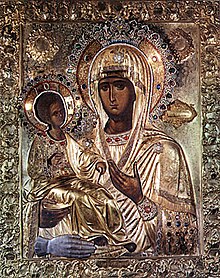Hilandar
As Hilandar's founder, Saint Symeon issued a special founding charter or chrysobulls, which survived until World War II, when it was destroyed as a result of the Operation Punishment and the notorious April 6, 1941 Nazi Germany bombing of Belgrade that leveled to the ground the National Library of Serbia building in Kosancicev Venac.[15] Following the relocation of Saint Symeon's remains, what would eventually become world-famous grapevines began growing on the spot of his old tomb, which gives to this day miraculous grapes and seeds that are shipped all over as a form of blessing to childless married couples.In order to effectively deal with consequences of the Crusader Latin plunder, King Uroš the Great constructed a large fortification surrounding the monastery with the protective tower named after the Transfiguration of Christ.In the early 14th century, pirate mercenaries of the Catalan Grand Company repeatedly raided the Holy Mountain, while looting and sacking numerous monasteries, stealing treasures and Christian relics, and terrorizing monks.[23][24] Milutin also added a new main entrance gate which a chapel dedicated to Saint Nicholas built in, in addition to the newly erected monastery dining chamber.At that time the number of Serbian monks skyrocketed and monasticism flourished even further as Byzantine Emperor Andronikos II Palaiologos donated large pieces of land to the monastery's estate in Greece.He also took his wife Empress Jelena with him, thus creating a precedent and violating the strict tradition of "avaton" that bars women from stepping into Mount Athos.In memory of Emperor Dusan's visit, the Hilandar monks erected big cross and planted the "imperial olive tree" on the spot where they welcomed him.Serbian Emperor also built the Church of St. Archangels and expanded the monastery's hospital around 1350, while Empress Jelena endowed the Karyes monastic cell dedicated to St. Sava which belongs to Hilandar.In addition to Dusan's son Serbian Emperor Uros V, powerful noblemen also supported Hilandar, such as Prince Lazar Hrebeljanovic who constructed the narthex along the west side of the main Entry of the Lady Theotokos into the Temple Church in 1380.Following the fall of the Serbian Despotate to the Ottoman Turks in 1459, Hilandar lost major guardians and benefactors as its brotherhood looked for support from other sources.[34] Ilarion Makariopolski, Sophronius of Vratsa and Matey Preobrazhenski had all lived there, and it was in this monastery that Saint Paisius of Hilendar began his revolutionary Slavonic-Bulgarian History.Among the numerous relics and other holy objects treasured at the monastery is the Wonderworking Icon of the Theotokos "Of the Akathist", the feast day of which is celebrated on January 12.The monastery also possesses the Wonderworking Icon of the Theotokos "Of the Three Hands" (Greek: Tricherusa, Serbian: Тројеручицa), traditionally associated with a miraculous healing of St. John Damascene.








Chilandar, IranHilander FoodsMonastic community of Mount AthosSerbian OrthodoxEastern Orthodox ChurchThree-handed TheotokosVirgin MaryDioceseMount AthosSaint SavaSaint SymeonEcumenical Patriarch of ConstantinopleGreeceCoordinatesromanizedSerbian CyrillicEastern OrthodoxSerbianOrthodoxGrand Principality of SerbiaStefan NemanjaArchbishop of SerbiaAthonitehistoricalmonasteryTrojeručicachelandionByzantineAlexios III AngeloschrysobullsmonasticIberiaAmalfiProtosSerbian peopleGrand Prince of SerbiaEntry of the Lady Theotokos into the TempleGrand PrinceStefan "the First-Crowned" KingWorld War IIOperation PunishmentNazi GermanyBelgradeNational Library of SerbiaKosancicev VenacSerbiametochionsMetohijaStudenica MonasterygrapevinesKaryesKaryes TypikonmonasticismHilandar TypikontypikonMonastery of Theotokos EvergetisConstantinopleArchbishopSerbian Orthodox ChurchFourth CrusadeCrusadersLatin OccupationHoly LandThe Holy Lavra of Saint Sabbas the SanctifiedPalestineSt. John of DamascusMar Saba monasterySabbas the SanctifiedhegumenStefan RadoslavStefan VladislavCrusaderUroš the GreatTransfiguration of ChristKing Dragutinmetochionmonastic republicmercenariesCatalan Grand CompanyHoly MountainDanilo IIStefan MilutinKing of SerbiaChrist PantocratorKing MilutinSaint NicholasAndronikos II PalaiologosSerbian Double EagleNemanjićSaint Sava timeSerbian KingEmperor DusanEmpress Jelenaolive treeArchangelsSt. SavaSava IVUros VLazar HrebeljanovicnarthexKing Aleksandar ObrenovićThe Byzantine EmpireOttoman TurksOttoman EmpireOttoman sultansMurad IIMehmed II1453 Fall of ConstantinopleSerbian DespotateWallachiansMara BrankovićĐurađ BrankovićDespot Stefan BrankovicAngelina BrankovicVasili III IvanovichHigh PorteRussian TsarIvan IVIvan the TerribleIvan IV VasilyevichAna JakšićJakšić noble familyHelena, Empress Consort of ByzantiumMoscowKremlinRussian
